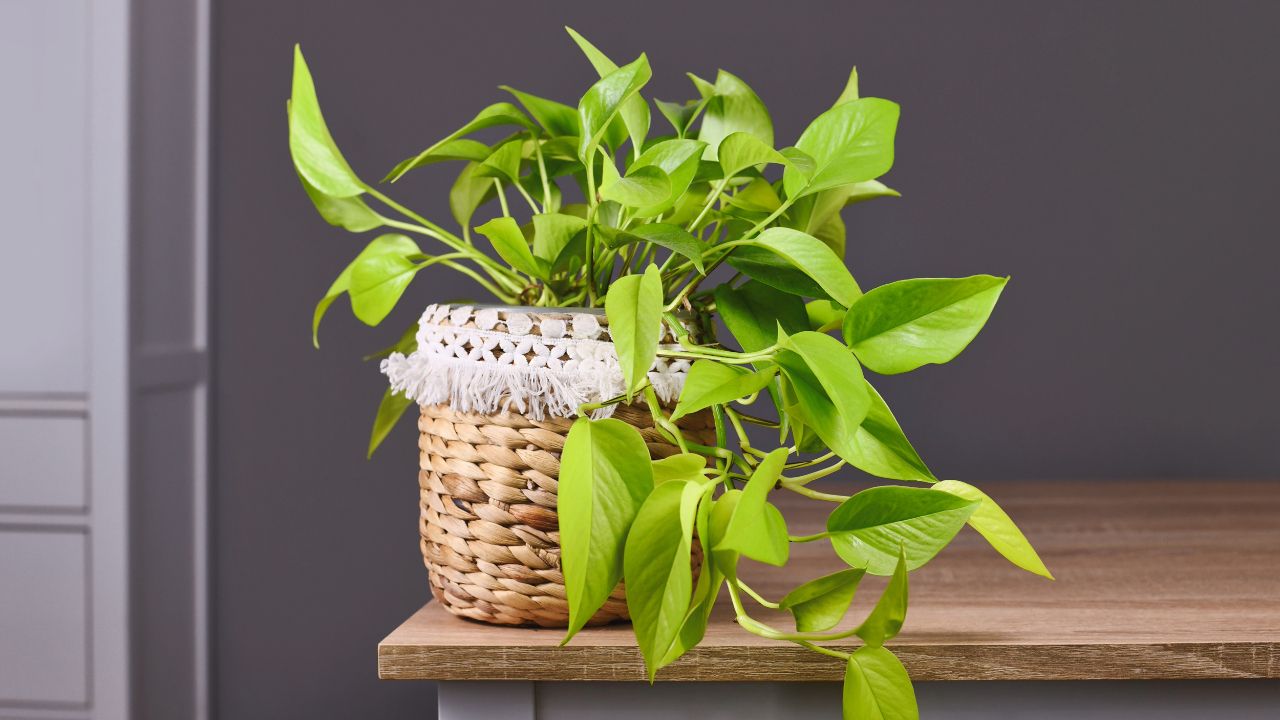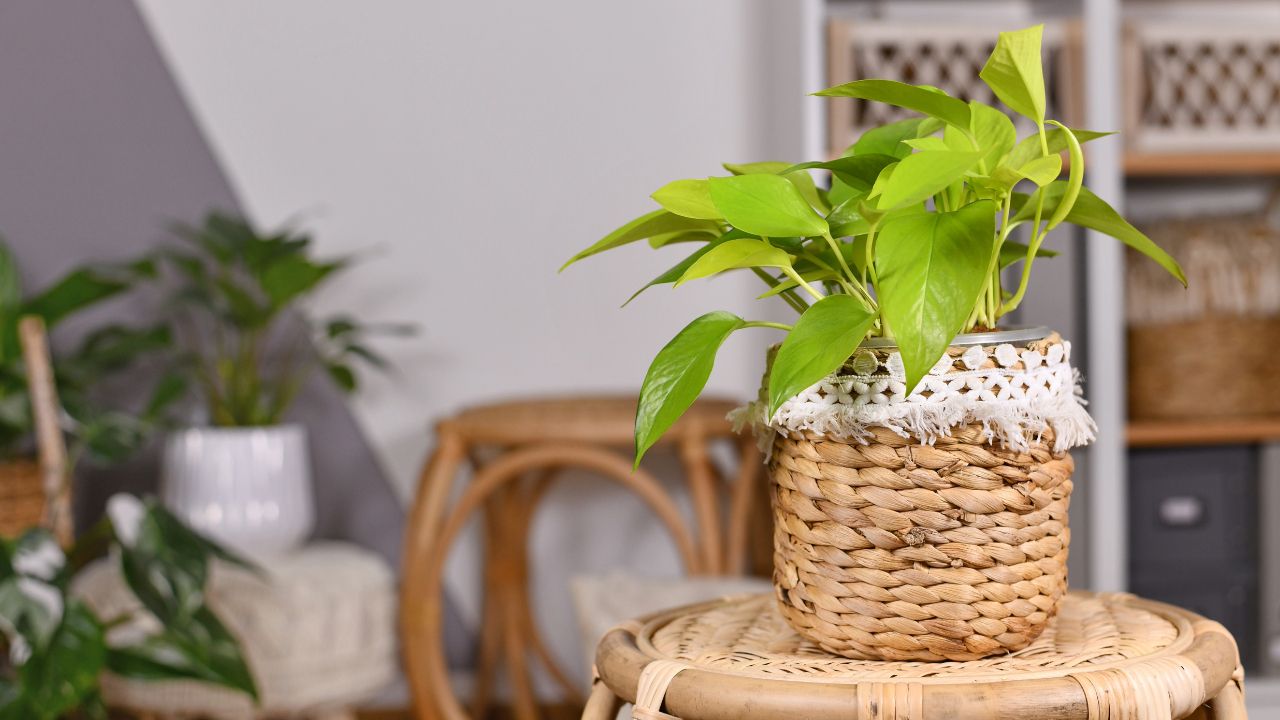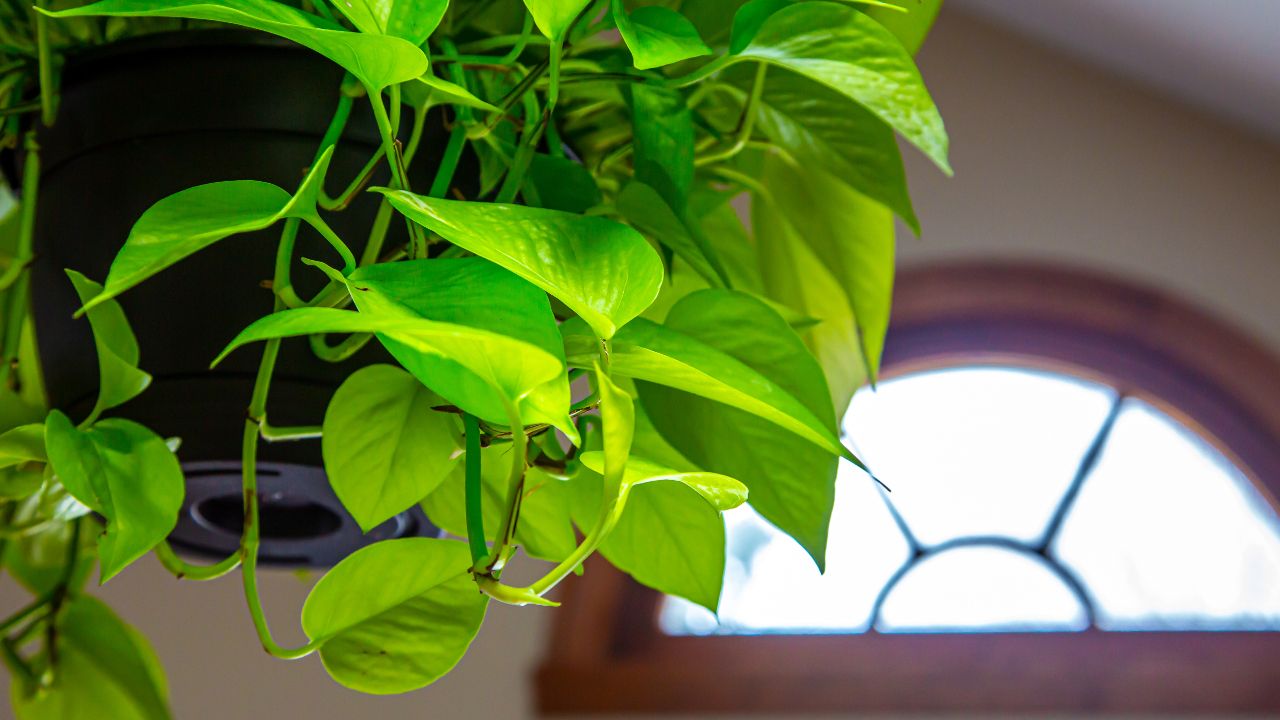
At a Glance: Neon Pothos
- Botanical Name: Epipremnum aureum 'Neon'
- Common Name: Neon Pothos
- Family: Araceae
- Plant Type: Perennial Vine
- Mature Size: Up to 10 ft long and 3 ft wide (indoors)
- Sun Exposure: Partial
- Soil Type: Loamy, Moist but Well-Drained
- Soil pH: Acidic
- Bloom Time: Spring to Summer
- Flower Color: Green and White
- Hardiness Zones: 11a, 11b, 12a, 12b
- Native Area: Australia
- Toxicity: Toxic to both pets and people
Step into a world where foliage transcends the ordinary—welcome to the captivating universe of neon pothos plants. A superstar among indoor plants, the neon pothos elevates any space with its stunning, vibrant leaves that practically glow. This isn't just another green leafy ornament for your home; it's a statement in botanical beauty.
Favored for its resilience and easy care, the neon pothos plant is more than just an aesthetically pleasing addition. Its bright green, heart-shaped leaves offer a touch of the tropical to even the most urban of spaces. Imagine the burst of color and life a well-placed pot can bring to your living room, bedroom, or office. Yes, neon pothos care is that transformative!
In this comprehensive guide, we'll delve into everything you need to know to keep your neon pothos not just alive, but thriving. From neon pothos care essentials to tips for avoiding common problems like root rot, we've got you covered. Let's embark on a journey to unlock the secrets of this beautiful plant and ensure your neon pothos grows to its full potential.
Join our newsletter
Stay on top of the latest in landscaping and lawn care with one valuable tip right in your inbox every Saturday morning.
Understanding Neon Pothos Plant Varieties
When it comes to the fascinating world of pothos plants, diversity is the name of the game. You might have come across different types of pothos, like the golden pothos or jade pothos, each with its unique features. However, the neon pothos stands out in this crowd for several compelling reasons.
Unique Characteristics of Neon Pothos
- Vibrant Color: The first thing that grabs your attention about a neon pothos plant is its vibrant, bright green leaves. Unlike other pothos varieties, which may have variegated or darker leaves, neon pothos leaves are a solid, eye-catching hue.
- Heart-Shaped Leaves: While other pothos plants also sport heart-shaped leaves, the neon pothos accentuates its striking color with this endearing leaf shape, making it a beautiful plant that captures hearts and imaginations.
- Growth Pattern: While you can train many pothos plants to climb a moss pole or hang gracefully from a basket, neon pothos tends to grow in a bushier pattern, especially when given enough light and pruned correctly.

How Does Neon Pothos Differ from Other Pothos Plants?
- Light Requirements: Unlike some pothos varieties that can tolerate lower light conditions, the neon pothos thrives in bright indirect light, allowing its vibrant color to shine through.
- Toxicity Level: Like other pothos plants, neon pothos is toxic when ingested, but the vibrant color often makes it more attractive to pets, something to consider in neon pothos care.
- Rate of Growth: With optimal conditions, you'll find that neon pothos grow faster compared to other pothos plants. This makes them excellent choices for those looking to quickly fill a space with lush greenery.
In a nutshell, neon pothos sets itself apart with its unique characteristics, making it a prized addition to any indoor plant collection. Its specific care requirements and growth patterns distinguish it clearly from other pothos varieties, offering plant enthusiasts a vibrant alternative in pothos plant care.
The Ideal Environment for Neon Pothos Care
Understanding the environment in which your neon pothos thrives is crucial for its long-term health and vibrant appearance. Two environmental factors stand out: lighting and temperature and humidity. Let's delve into each of these essential components of neon pothos care.
Bright Indirect Light: The Lifeline of Neon Pothos
When it comes to lighting, neon pothos plants are somewhat finicky but in a manageable way. These plants love bright indirect light, which keeps their leaves vibrant and encourages healthy growth. Placing your neon pothos near a window where it can get filtered sunlight is an excellent idea. Too much direct sunlight, however, can cause the leaves to fade, losing their signature neon glow.
The Role of Temperature and Humidity
- Temperature: Neon pothos flourish in warm temperatures, typically between 65 and 80°F (18-27°C). Cold drafts and sudden temperature fluctuations can lead to brown spots on the leaves, an issue you certainly want to avoid.
- Humidity: These plants aren't too demanding when it comes to humidity. They're usually content with average household humidity but will appreciate a more humid environment. This is particularly true during the growing season, where higher humidity can spur faster growth.
Pro Tip: Place a humidifier nearby or group your neon pothos with other plants to increase local humidity levels.
Creating the ideal environment for your neon pothos plant care journey is not complicated, but it does require attention to detail. A well-lit room with controlled temperature and humidity levels will keep your neon pothos in optimal condition, adding life and color to your indoor spaces.

Soil and Watering—Keys to Neon Pothos Health
One of the most common pitfalls in neon pothos care is overlooking the basics: soil and watering. These two factors are foundational to the plant's well-being and directly influence its resistance to issues like root rot.
The Right Soil Mix for Neon Pothos
When planting or repotting your neon pothos, choosing the correct soil mix is crucial. An all-purpose potting mix usually suffices, but you can enhance it with some orchid bark for better aeration. Ensure that your pot has proper drainage holes at the bottom to avoid soggy soil, which can lead to root rot.
Quick Tip: You can also add a layer of pebbles at the bottom of the pot to improve drainage and soil moisture regulation.
Proper Watering to Prevent Root Rot
Watering your neon pothos needs careful attention. Over-watering is a common mistake that can lead to root rot, a condition that can severely damage your plant. Here's how to avoid it:
- Frequency: Water your neon pothos when the top inch of the soil feels dry to the touch.
- Volume: Provide enough water to soak the root ball but avoid flooding the entire plant.
- Environmental Considerations: During warmer temperatures, you may need to water more frequently, but reduce the volume during the colder months.
Pro Tip: Yellow leaves can be a sign of over-watering, while brown leaf tips might indicate the plant is too dry.
By understanding the soil and watering requirements of your neon pothos, you can preempt many common issues and ensure your plant thrives. Given the proper soil mix and a well-balanced watering schedule, your neon pothos will continue to be a beautiful addition to your indoor plants collection.

Propagation and Stem Cuttings—Grow More Neon Pothos
Growing your neon pothos doesn't have to be a singular experience. One of the most rewarding aspects of neon pothos care is the ease with which you can propagate new plants. Plus, with a little care, you can encourage your neon pothos to grow into a bushier, more vibrant specimen.
Propagating Neon Pothos from Stem Cuttings
Starting a new neon pothos plant from stem cuttings is a relatively straightforward process. Here's a simple guide:
- Cutting: Use clean, sharp scissors to take a 4-6 inch cutting from a healthy stem, making sure it includes at least one leaf node.
- Rooting Medium: You can root the cutting in water or directly in soil. If using soil, a mix of potting soil and perlite works well for good drainage.
- Rooting Hormone: While not essential, a dab of rooting hormone can speed up the process.
- Planting: Place the cutting in the rooting medium, ensuring the leaf node is buried.
- Care: Keep the cutting in indirect light and maintain high humidity for optimal root development.
Note: Once roots are about 2 inches long, your new neon pothos plant is ready for repotting.
How to Make Your Neon Pothos Grow Bushier
If you'd like to make your neon pothos plant bushier, consider pruning it. Cut back long vines just above a leaf node to encourage new growth. The plant will typically respond by producing more stems, contributing to a fuller, bushier appearance.
Pro Tip: The cuttings you remove for pruning can be used for propagation, creating a win-win situation: a bushier plant and new plants to grow!
By mastering the art of propagation and understanding how to encourage bushier growth, you can maximize the beauty and extent of your neon pothos plants.
Join our newsletter
Stay ahead of the curve in all things outdoor.
Get the inside scoop on the latest landscaping, lawn care, and fencing trends with 1 actionable tip every Saturday morning.
Pothos Plants and Pets—Is Neon Pothos Toxic?
As you embark on your neon pothos care journey, it's essential to consider every member of your household, including your furry friends. While neon pothos plants are a joy to have, they do come with a caveat—neon pothos is toxic to pets.
The Toxicity of Neon Pothos
The neon pothos contains calcium oxalate crystals that can cause irritation in the mouth, tongue, and lips of animals if ingested. It's important to know that this toxicity isn't limited to just neon pothos; it's a trait common to most pothos plants.
What to Do if Pets Interact with the Plant
- Immediate Measures: If you suspect your pet has ingested any part of the neon pothos plant, it's crucial to consult a veterinarian immediately. Quick action can mitigate potential harm.
- Preventive Measures: The best way to protect your pets is to place your neon pothos out of their reach. Hanging baskets or high shelves are ideal locations.
- Alternative Plants: If you find that keeping the plant away from your pets is too challenging, consider switching to non-toxic indoor plants like the spider plant or lemon lime philodendron.
Being aware of the toxicity levels of your houseplants ensures a safer environment for everyone in your home. While neon pothos adds a stunning aesthetic to your décor, safety should always be a cornerstone of your neon pothos care strategy.
Common Pests and Problems in Neon Pothos Care
While neon pothos are relatively low-maintenance, like all plants, they can sometimes fall victim to pests and other issues. Identifying and tackling these problems early on is essential for maintaining the vibrant color and healthy growth of your neon pothos plants.

Identifying Spider Mites and Other Common Pests
The most common pests affecting neon pothos include spider mites. These tiny nuisances are often found on the undersides of leaves and can cause a dusty, mottled appearance. You may also notice tiny webs between leaves and stems.
How to Deal:
- Isolate the affected plant to prevent spreading.
- Treat with insecticidal soap or neem oil, ensuring full coverage of all plant surfaces.
Solutions for Brown Leaf Tips and Brown Spots
Brown Leaf Tips: If you notice brown leaf tips, this could be a sign of under-watering or too much direct sunlight. It's crucial to adjust your neon pothos watering schedule and ensure that it's exposed to bright indirect light, rather than direct sun.
Brown Spots: Brown spots can emerge due to over-watering or sudden temperature fluctuations. Ensuring a consistent watering schedule and warm temperatures will keep your neon pothos in optimal condition.
Quick Fixes:
- Trim off the affected areas with sterilized scissors.
- Ensure proper neon pothos light requirements are met.
- Check for drainage issues and resolve them promptly.
Pro Tip: Regularly wiping down the leaves and inspecting your neon pothos can help you catch issues before they escalate, making neon pothos care a lot more manageable.
While these issues can be alarming, early detection and the right care regimen can mitigate most problems, ensuring your neon pothos continues to be a healthy and beautiful plant.
Extra Care for Thriving Neon Pothos Plants
Caring for your neon pothos doesn't have to stop at basic needs like soil and watering. To truly make your neon pothos thrive, a few extra steps in your care routine can go a long way. From fertilizer to light adjustments, these tips are designed to promote vibrant color and healthy growth.
Fertilizer Requirements for Neon Pothos
Your neon pothos will benefit from regular feeding, especially during its growing season. A balanced liquid fertilizer is recommended for this. Here’s how to go about it:
- Frequency: Fertilize every 4-6 weeks during the growing season.
- Type: A balanced liquid fertilizer will provide all the essential nutrients.
- Application: Follow the manufacturer's instructions carefully to avoid nutrient imbalances.
Pro Tip: Over-fertilization can lead to salt buildup in the soil, affecting the neon pothos leaves and overall health. If you see signs of nutrient imbalance, flush the soil with water.
Light Adjustments for Vibrant Color and Healthy Growth
The light conditions play a significant role in the color and growth pattern of your neon pothos. For maintaining vibrant color:
- Brightness: Keep your neon pothos in bright indirect light to maintain its vibrant color.
- Adjustment: Rotate the plant every few weeks to ensure even exposure.
- Signs of Inadequate Light: Leggy growth and less vibrant leaves can be a sign that your plant needs more light.
By giving focused attention to these two aspects—fertilization and light conditions—you can elevate your neon pothos care routine and help your plant reach its full potential.
Your Next Steps in Neon Pothos Care
Congratulations! You've just armed yourself with a comprehensive guide to growing a thriving neon pothos plant. From understanding the uniqueness of neon pothos varieties to mastering the ideal environment for their care, you're well on your way to becoming an expert. We've covered the essentials—soil mix, watering, and even how to tackle common pests like spider mites. Plus, you now know how to give your neon pothos the extra love it needs through proper fertilization and light adjustments.
Growing a neon pothos is not just about keeping a plant alive; it's about fostering a vibrant, healthy, and ever-expanding member of your indoor plant collection. So don't wait! Embark on your neon pothos care journey today and watch your green friend thrive.
Join our newsletter
Stay ahead of the curve in all things outdoor.
Get the inside scoop on the latest landscaping, lawn care, and fencing trends with 1 actionable tip every Saturday morning.